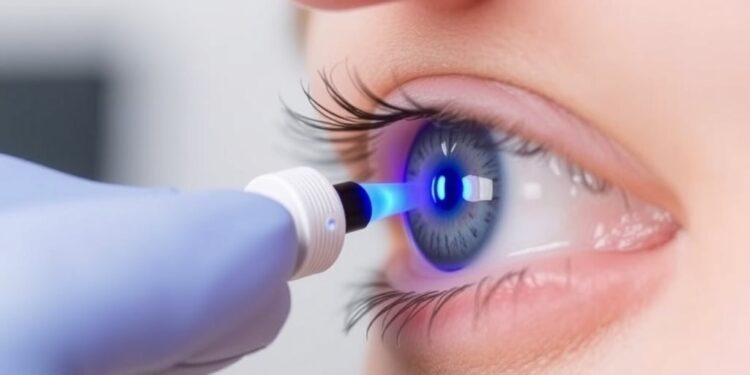In a groundbreaking study poised to redefine our understanding of corneal surgery outcomes, researchers have unveiled a novel corneal indentation device designed to assess the corneal tangent modulus before and after Femtosecond Laser-Assisted LASIK (FS-LASIK) procedures. This innovative approach comes in response to the increasing concerns over postoperative corneal biomechanics, particularly in relation to complications such as corneal ectasia. The insights drawn from this research promise to enhance the safety and efficacy of refractive surgeries, offering another layer of precision to an already intricate field.
Corneal refractive surgery has gained immense popularity over the years, primarily for its ability to correct refractive errors like myopia and astigmatism effectively. The allure of these procedures lies in their minimal invasiveness and high success rates, which have made them a first choice for millions seeking freedom from glasses and contact lenses. However, the prevention of long-term complications continues to challenge eye care professionals, motivating ongoing research into the underlying biomechanics of the cornea during and after surgical interventions.
Throughout the study, a comprehensive evaluation of the changes in corneal biomechanics pre- and post-surgery was conducted, particularly focusing on the tangent modulus. This parameter, alongside Young’s modulus, plays a vital role in characterizing the elastic properties of the cornea, which can drastically influence its ability to withstand intraocular pressure changes postoperatively. Despite the use of well-established devices like the Ocular Response Analyser and Corvis ST for measuring some corneal parameters, the effects of FS-LASIK on the tangent modulus have been insufficiently investigated in human subjects.
Crucially, the new corneal indentation device provides a non-invasive mechanism to accurately measure the biomechanical response of the corneal tissue. This enhances previous methods and aims to fill the existing knowledge gaps regarding corneal elasticity following laser surgery. By assessing changes in the corneal tangent modulus specifically, the research endeavors to contribute valuable data to developing predictive models in surgical outcomes, ultimately seeking to mitigate risks associated with advanced refractive surgical techniques.
The study, which involved sixty-six patients undergoing FS-LASIK, revealed significant alterations in central corneal thickness (CCT), corneal radius, and Goldmann intraocular pressure (GAT IOP) at the six-month follow-up mark. These results underscored the transformative effects of laser surgery, but more importantly, they led to the pivotal discovery that corneal stiffness remained statistically unchanged after the procedure. This lack of significant change in corneal stiffness suggests a complex interplay between corneal parameters that warrants further exploration.
Most notably, the research highlighted a profound increase in the corneal tangent modulus following FS-LASIK, which was statistically significant. The outcomes indicate an increase in modulus values alongside decreases in CCT and corresponding increases in corneal radius, forming essential correlations necessary for evaluating individual surgical outcomes. Understanding how these variables interact is vital for tailoring future surgeries and improving patient-specific strategies that could result in a reduction of postoperative complications.
Details of the findings illuminate the relationship between corneal modulus changes and both corneal thickness and radius. A one-millimeter increase in corneal radius was directly associated with a 0.23 MPa rise in corneal modulus, while reductions in corneal thickness led to a 0.14 MPa increase. This data emphasizes the need for clinicians to consider these relationships when assessing patient-specific risks associated with FS-LASIK and customizing treatment plans accordingly.
Such advances in the understanding of corneal biomechanics may significantly influence the guidelines and practices of refractive surgery in the future. By enhancing our comprehension of the biomechanical reactions involved during surgical procedures, eye care practitioners will be better armed to inform patients about potential changes and the implications for long-term ocular health. As researchers delve deeper into the nuances of post-surgical corneal behavior, the potential for improved patient care remains promising.
The continuing evolution of laser surgical techniques highlights an ever-increasing necessity for innovation in measurement devices, such as the corneal indentation device. This novel tool plays an essential role not only in defining the corneal properties more accurately but also in safeguarding the future of refractive surgery. With its ability to deliver precise measurements without invasiveness, it aligns seamlessly with the goals of modern ophthalmic practices that prioritize patient comfort and safety.
In conclusion, this pioneering study not only sheds light on the mechanical properties of the cornea post-FS-LASIK but also sets the stage for a future where customized, data-driven surgical interventions become the norm. By robustly understanding how various parameters interact and affect corneal behavior, the ophthalmic community can advance their treatment methodologies, ultimately enhancing patient satisfaction and outcomes following refractive surgeries.
As the medical community absorbs these findings, further research will likely focus on leveraging these insights to refine surgical techniques. A shift toward personalized medicine in the sphere of refractive surgery, informed by detailed biomechanical understanding, could lead to a new era of enhanced safety and efficacy. The potential changes in corneal behavior following surgery will continue to remain a top priority for ongoing studies, ensuring that new developments in this field anticipate and address the needs of patients while advancing the science of ophthalmology in profound ways.
Subject of Research: Corneal biomechanics and FS-LASIK outcomes
Article Title: A novel corneal indentation device for comparison of corneal tangent modulus before and after FS-LASIK in vivo
News Publication Date: 2025
Web References: N/A
References: N/A
Image Credits: N/A
Keywords: corneal biomechanics, FS-LASIK, tangent modulus, corneal stiffness, refractive surgery, ocular health




